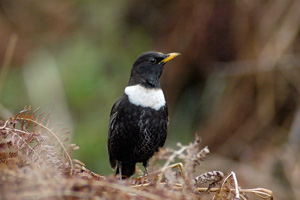Ring Ouzels

Help to protect Ring Ouzels on the Sheffield Moors
Ring Ouzels arrive back at Stanage and Burbage every March to breed after a marathon flight from their wintering grounds in North Africa. With the area also attracting more than half a million human visitors each and every year, it is a source of great pride that by working together, Ring Ouzels and people can co-exist in these precious landscapes.
Why do they need protecting and how can you help?
Ring Ouzels, also known as Mountain Blackbirds, are part of the heritage of Stanage and Burbage. But nationally numbers are declining dramatically and they are red-listed as a species of major conservation concern. Based on British Trust for Ornithology figures, numbers fell by 72% between 1991 and 2012.
Stanage and Burbage are designated at the highest European level as a Special Protection Area for rare upland birds. The following measures to protect Ring Ouzels, agreed through the Stanage Forum process, will also help others that nest and feed, including Snipe, Curlew, Reed Bunting, Whinchat, Wheatear and Linnet.
These should not restrict your enjoyment but could greatly help nesting success:
- Keep your dog on a lead. Dogs cause serious problems for birds like the Ring Ouzel just by being nearby. This is important during breeding and after fledging when the young may be concealed in the bracken below the nest sites.
- Cause for alarm. If you hear their alarm call – an angry “tac tac tac!” please move away quietly (about 50 metres) and avoid the area if you can. You may be preventing an adult bird from feeding its chicks.
- Keep to the main paths. You may be asked to avoid certain paths where birds nest and feed. Signs will show alternative routes and you will still be able to gain access to all climbing and bouldering areas.
- Watch the signs. Occasionally birds may nest in popular areas and these might warrant special safeguards for short periods of time. Date-specific signs agreed with the British Mountaineering Council will be erected on site. Please follow the guidance.
- Don’t drop litter. Even if it is biodegradable, it may attract more crows and magpies, which eat other birds’ eggs.
- Keep your distance. Please refrain from taking close-up photographs.
Your help is especially important during the breeding season, from the beginning of March to the end of July.
Where and when can I see Ring Ouzels?
Ring Ouzel look like blackbirds but with a white crescent on their breast.
This shy, rock-loving bird prefers a nest site on or below the Edges, usually overhung with rock or vegetation, but they sometimes nest in bracken.
The males can often be seen singing from a rock or flying low across the moor to collect food. Early in the season (March/April) is often the best time to see them as they noisily sing from prominent crags and boulders to proclaim their territory, but you’ll have to pick your time – dawn and dusk are best.
They feed on worms, insects in the bracken, and later in the year, bilberry and rowan berries. Bizarrely, the roadside mounds have become their favourite feeding areas in recent years, due to the fertile soil attracting worms and other invertebrates. It is common for them to nest twice in a season, between early April and the end of June.
Report sightings
You can report sightings of Ring Ouzels in one of the following ways:
- National Park Ranger - telephone: 0783 162 5397
- Eastern Moors Partnership - telephone: 0114 2891543
- Sheffield Bird Study Group
- Moors For the Future Community Science Project

